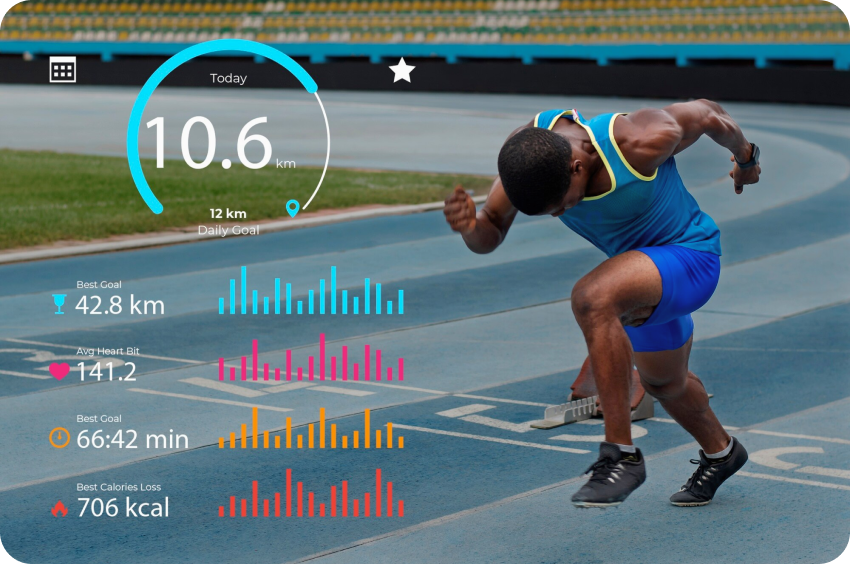Triathlon is a multisport event that consists of swimming, cycling, and running.
It is a challenging sport that requires athletes to be proficient in all three disciplines.
Triathletes need to follow a structured training plan to achieve their race goals.
A training plan is a roadmap that helps athletes prepare for a race.
It outlines the workouts that athletes need to do, the intensity of those workouts, and the frequency of the workouts.
Training plans are typically tailored to the individual athlete’s needs and goals.
This article will discuss the following main points about training schedules for triathletes:
– What is a training plan?
– The benefits of following it
– How to use a plan for training
– Common mistakes to avoid
In the following sections, we will explore each of these topics in more detail.
So let’s start our journey.
Some Statistic
According to a study published in the journal Triathlete, athletes who followed a structured training procedure improved their performance by an average of 10%.
The study also found that athletes who followed a special workout routine were less likely to suffer injuries.
Another study published in the Journal of Sports Science & Medicine found that athletes who followed a plan were more likely to achieve their race goals and perform better on a race day.
The study found that 85% of such athletes finished their race within their goal time.
What Is a Training Plan?
This is a schedule of workouts that are designed to help athletes achieve their race goals.
Plans typically include workouts for all three disciplines of triathlon: swimming, cycling, and running.
Importance of Training Schedules for Triathletes
Workout plans are important for triathletes because they help athletes to:
- Improve their performance
- Reduce their risk of injury
- Increase their motivation and accountability
- Train more efficiently
- Benefits of following a structured training routine
What Is Included in a Triathlon Plan?
A triathlon preparation schedule typically includes various workouts to improve endurance, strength, and technique across swimming, cycling, and running disciplines.
Here’s a breakdown of what might be included in such a plan:
- Swimming Workouts
- Distance swim sessions to build endurance.
- Interval training to improve speed and stamina.
- Technique drills to refine stroke mechanics.
- Open water swims to practice navigation and adaptability.
- Cycling Workouts
- Long rides to build endurance and mental toughness.
- Interval training, such as hill repeats or intervals on flat terrain, to improve speed and power.
- Cadence drills to enhance pedaling efficiency and push harder efforts.
- Brick workouts (bike immediately followed by a run) to simulate race conditions.
- Running Workouts
- Long runs to build endurance and mental resilience.
- Speed work like intervals or tempo runs to improve race pace.
- Hill repeats to challenge yourself and build strength and power.
- Transition runs (run immediately after biking) to get accustomed to the feeling of running off the bike.
- Strength Training
- Core exercises to improve stability and prevent injuries.
- Resistance training to build overall strength, especially in the legs and upper body.
- Plyometric exercises to improve power and explosiveness.
- Rest and Recovery
- Scheduled rest days to allow the body to recover and adapt to training stress.
- Active recovery activities like swimming, cycling, or yoga to promote blood flow and muscle relaxation.
- Adequate sleep and nutrition to support training and recovery.
- Race-specific Preparation
- Practice transitions (switching from swim to bike and from bike to run) to minimize time lost during the race.
- Race simulation workouts to practice pacing, nutrition, and mental strategies.
- Nutrition and Hydration
- Guidance on pre-workout, during workout, and post-workout nutrition to support training and recovery.
- Hydration strategies tailored to individual needs and environmental conditions.
- Flexibility and Mobility
- Stretching routines to improve flexibility and prevent injury.
- Mobility exercises to maintain range of motion and joint health.
- Goal Setting and Monitoring
- Setting specific, measurable, attainable, relevant, and time-bound (SMART) goals for training and races.
- Regular monitoring of progress through performance metrics like pace, heart rate, and perceived exertion.
- Periodization
- Structured training phases (e.g., base phase, build phase, peak phase, taper) to progressively increase training load and optimize performance for peak events.
- Mental Preparation
- Visualization and mental rehearsal techniques to enhance focus and confidence.
- Strategies for managing race-day nerves and overcoming challenges during training and racing.

Remember, a well-rounded triathlon training plan should be tailored to your abilities, goals, and lifestyle factors. It may require adjustments based on feedback and progress throughout the training cycle.
It’s also important to listen to your body and prioritize injury prevention and overall well-being.
Benefits of a Triathlon Training Plan
Here are some of the benefits of following a structured workout schedule:
1) Improved performance
A well-designed plan will help you improve your performance in all three triathlon disciplines.
2) Reduced risk of injury
A structured routine will help you gradually increase your training volume and intensity, reducing your risk of injury.
3) Increased motivation and accountability
A plan can help you stay motivated and accountable for your training.
4) More efficient training
A training routine will help you make the most of your training time by ensuring you are doing the right workouts at the right intensity.
Types of Training Plans
There are many different types of training schedules available, each tailored to different needs and goals.
Some common types include:
1) Beginner training plans
Beginner plans are designed to help athletes who are new to triathlon or who have a low level of fitness.
These typically focus on building endurance and improving technique.
2) Intermediate training plans
Intermediate training routines are designed for athletes who have some experience with triathlon and who are looking to improve their performance. For example, you have already participated in a sprint race and are now preparing for an Olympic distance triathlon.
Intermediate-level workouts typically include more intense trainings and a greater focus on speed.
3) Advanced training plans
Advanced workout plans are designed for elite athletes who are looking to achieve their best possible performance.
These workout routines typically include intense workouts and a high volume of training.
How to Choose the Right Triathlon Plan?
To choose the right training plan, you should consider the following factors:

1. Your Fitness Level and Experience in Triathlon
If you are new to triathlon or have a low level of fitness, start with a beginner plan.
Your workouts will be focused on building endurance and improving technique.
If you are already in good shape, you can start with an intermediate or advanced routine.
2. Your Race Pace Goals
What are you hoping to achieve in your triathlon?
Are you looking to finish your first race, or are you trying to qualify for a world championship?
Your race goals will help you to choose a training plan that is appropriate for your level and experience.
3. The Amount of Time You Have to Train
How much time do you have to train each week?
Be realistic about how much time you can commit to training and choose a plan that fits your schedule.
Once you have considered these factors, you can start to look for training programs.
You can also hire a triathlon coach to create a personalized training plan for you.
The Benefits of Following a Training Plan
There are a few reasons why following a training program can lead to improved performance.
First, a training plan ensures that you are doing the right workouts at the right intensity.
Second, a training plan helps you to increase your training volume and intensity over time gradually.
This helps to prevent overtraining and injuries.
Third, a training routine provides you with a roadmap to follow, which can help you to stay motivated and accountable.
Following a structured plan has many benefits for triathletes.
These benefits include:
Improved performance
Reduced risk of injury
Increased motivation and accountability
More efficient training
Let’s explore them in more detail.

1. Improved Performance
A well-designed training schedule will help you improve your performance in all three triathlon disciplines.
The plan will gradually increase the volume and intensity of your workouts over time, which will help you build endurance and speed.
For example, a beginner training plan might start with three workouts per week, with each workout lasting for 30 minutes.
Over time, the training plan might progress to six workouts per week, with each workout lasting for 60 minutes.
The intensity of the workouts would also increase over time.
As you follow the training plan, you will notice that your fitness improves and your performance increases.
You will be able to swim faster, bike longer, and run faster.
2. Reduced Risk of Injury
A structured plan will gradually increase the volume and intensity of your workouts over time, which will help to prevent overuse injuries.
The training program will also include workouts that are designed to strengthen your muscles and improve your flexibility.
This can help to prevent injuries such as shin splints, stress fractures, and muscle strains.
3. Increased Motivation and Accountability
Having a training plan can help you to stay motivated and accountable for your training.
The plan gives you a roadmap to follow and helps you to stay on track.
If you don’t have a training plan, getting sidetracked or skipping workouts is easy.
But when you have a plan, you are more likely to stick to it, even when you don’t feel like it.
4. More Efficient Training
A training plan can help you to make the most of your training time.
The plan ensures that you are doing the right workouts at the right intensity.
The training plan will also help you to avoid overtraining.
Overtraining can lead to injuries and decreased performance.
However, a well-designed training plan will ensure that you get enough rest and recovery.
In conclusion, following a structured training plan has many benefits for triathletes.
These benefits include improved performance, reduced risk of injury, increased motivation and accountability, and more efficient training.
How to Use a Training Plan
Now that you know the benefits of following a training plan, it’s time to learn how to use one effectively.
A well-designed training plan will provide you with a roadmap to follow and help you achieve your triathlon goals.
However, it’s important to understand how to read and interpret your training plan, as well as how to adjust it to fit your individual needs and goals.

How to Read and Understand a Training Plan
Training plans vary in format, but they typically include the following information:
1) Workout type
This tells you what type of workout you will be doing, such as a swim workout, bike workout, or run workout.
2) Distance
This tells you how far you will be swimming, cycling, or running.
3) Intensity
This tells you how hard you should be working during the workout.
Intensity is often measured using heart rate zones or power zones.
4) Recovery time
This tells you how much time you should rest between workouts.
5) Rest days
This tells you how many days you should take off from training each week.
Here is an example of a typical training plan entry:
- Workout type: Swim workout
- Distance: 2,000 meters
- Intensity: Easy (Zone 2)
- Recovery time: 10 minutes
- Rest days: None
Tips for Following a Training Plan Consistently
Here are a few tips for following a training plan consistently:
1) Schedule your workouts in advance
This will help you to make time for your workouts and avoid skipping them.
2) Find a training partner
Training with a friend or group can help you to stay motivated and accountable.
3) Set realistic goals
Don’t try to do too much too soon. Set small, achievable goals for yourself and gradually increase the difficulty of your workouts over time.
4) Reward yourself
When you reach a goal, reward yourself with something special.
This will help you to stay motivated and on track.
Common Mistakes to Avoid
Even though training plans are beneficial, there are some common mistakes that triathletes make when following them.
By being aware of these mistakes, you can avoid them and achieve your triathlon goals.
Here are some common mistakes that triathletes make when following training plans:

1. Not Listening to Their Bodies
This is one of the biggest mistakes that triathletes make.
It is important to pay attention to how you are feeling during your workouts and to take rest days when needed.
Overtraining can lead to injuries and decreased performance.
2. Not Following the Plan
It is important to stick to your training plan as much as possible.
If you miss a workout, try to make it up later in the week.
However, don’t try to make up for missed workouts by doing too much too soon.
This can lead to overtraining.
3. Not Adjusting the Plan
As you get fitter, you will need to adjust your training plan to reflect your new fitness level.
If you are not sure how to adjust your plan, talk to a triathlon coach.
4. Not Fueling Properly
It is important to eat a healthy diet and drink plenty of fluids before, during, and after your workouts.
This will help you to recover from your workouts and perform at your best.
5. Not Getting Enough Sleep and Rest Day
Sleep is essential for recovery and performance.
Aim to get 7-8 hours of sleep per night.
By avoiding the common mistakes that triathletes make when following training plans, you can achieve your triathlon goals.
Conclusion
In this article, we have discussed the importance of training plans for triathletes.
We have provided tips on how to choose the right training plan, how to adjust it to fit your individual needs and goals, and how to follow it consistently.
I encourage you to follow a training plan to achieve your triathlon goals.
There are many different training plans available, so you can find one that is right for you.
If you are unsure how to choose a training plan or how to adjust it to fit your individual needs and goals, talk to a triathlon coach.
Good luck with your triathlon training!





